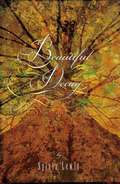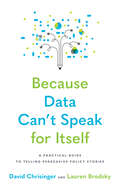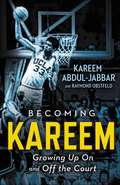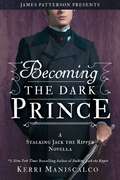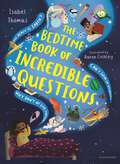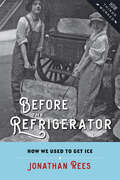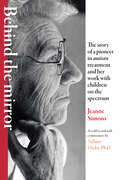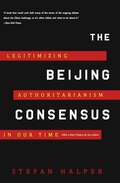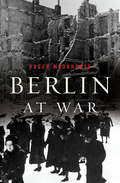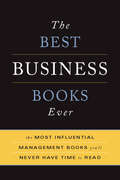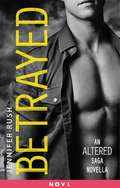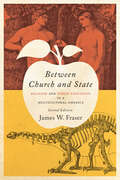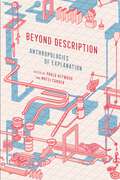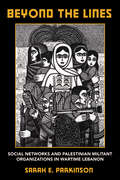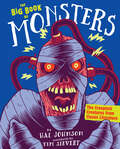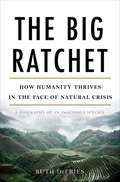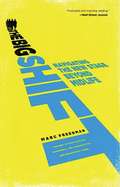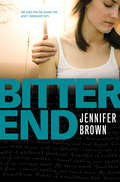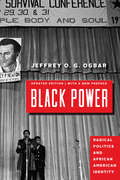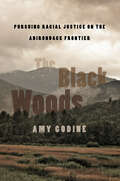- Table View
- List View
Beautiful Decay
by Sylvia LewisThings have a way of falling apart around Ellie Miller. Literally. With a touch that rots, she keeps everyone at a distance -- for others' safety as much as her own comfort. When newcomer Nate MacPherson makes it his mission to get close to Ellie, she does her best to steer clear. But as Nate reveals an unusual ability of his own, Ellie recognizes a kindred spirit who could accept her for who she is . . . if she lets him. As family secrets unravel, Ellie will have to discover the beauty within her reach in order to save the ones she loves.
Because Data Can't Speak for Itself: A Practical Guide to Telling Persuasive Policy Stories
by David Chrisinger Lauren BrodskyA guide for how to tell clear, data-driven stories that will make an impact.People with important evidence-based ideas often struggle to translate data into stories their readers can relate to and understand. And if leaders can't communicate well to their audience, they will not be able to make important changes in the world. Why do some evidence-based ideas thrive while others die? And how do we improve the chances of worthy ideas? In Because Data Can't Speak for Itself, accomplished educators and writers David Chrisinger and Lauren Brodsky tackle these questions head-on. They reveal the parts and functions of effective data-driven stories and explain myriad ways to turn your data dump into a narrative that can inform, persuade, and inspire action. Chrisinger and Brodsky show that convincing data-driven stories draw their power from the same three traits, which they call people, purpose, and persistence. Writers need to find the real people behind the numbers and share their stories. At the same time, they need to remember their own purpose and be honest about what data says—and, just as importantly, what it does not. Compelling and concise, this fast-paced tour of success stories—and several failures—includes examples on topics such as COVID-19, public diplomacy, and criminal justice. Chrisinger and Brodsky's easy-to-apply tool kit will turn anyone into an effective and persuasive evidence-based writer. Aimed at policy analysts, politicians, journalists, teachers, and business leaders, Because Data Can't Speak for Itself will transform the way you communicate ideas.
Because Data Can't Speak for Itself: A Practical Guide to Telling Persuasive Policy Stories
by David Chrisinger Lauren BrodskyA guide for how to tell clear, data-driven stories that will make an impact.People with important evidence-based ideas often struggle to translate data into stories their readers can relate to and understand. And if leaders can't communicate well to their audience, they will not be able to make important changes in the world. Why do some evidence-based ideas thrive while others die? And how do we improve the chances of worthy ideas? In Because Data Can't Speak for Itself, accomplished educators and writers David Chrisinger and Lauren Brodsky tackle these questions head-on. They reveal the parts and functions of effective data-driven stories and explain myriad ways to turn your data dump into a narrative that can inform, persuade, and inspire action. Chrisinger and Brodsky show that convincing data-driven stories draw their power from the same three traits, which they call people, purpose, and persistence. Writers need to find the real people behind the numbers and share their stories. At the same time, they need to remember their own purpose and be honest about what data says—and, just as importantly, what it does not. Compelling and concise, this fast-paced tour of success stories—and several failures—includes examples on topics such as COVID-19, public diplomacy, and criminal justice. Chrisinger and Brodsky's easy-to-apply tool kit will turn anyone into an effective and persuasive evidence-based writer. Aimed at policy analysts, politicians, journalists, teachers, and business leaders, Because Data Can't Speak for Itself will transform the way you communicate ideas.
Becoming Kareem: Growing Up On and Off the Court
by Raymond Obstfeld Kareem Abdul-JabbarA NEW YORK TIMES BESTSELLER! The first memoir for young readers by sports legend Kareem Abdul-Jabbar.At one time, Lew Alcindor was just another kid from New York City with all the usual problems: He struggled with fitting in, with pleasing a strict father, and with overcoming shyness that made him feel socially awkward. But with a talent for basketball, and an unmatched team of supporters, Lew Alcindor was able to transform and to become Kareem Abdul-Jabbar.From a childhood made difficult by racism and prejudice to a record-smashing career on the basketball court as an adult, Kareem Abdul-Jabbar's life was packed with "coaches" who taught him right from wrong and led him on the path to greatness. His parents, coaches Jack Donahue and John Wooden, Muhammad Ali, Bruce Lee, and many others played important roles in Abdul-Jabbar's life and sparked him to become an activist for social change and advancement. The inspiration from those around him, and his drive to find his own path in life, are highlighted in this personal and awe-inspiring journey.Written especially for young readers, Becoming Kareem chronicles how Kareem Abdul-Jabbar become the icon and legend he is today, both on and off the court.
Becoming the Dark Prince: A Stalking Jack the Ripper Novella (Stalking Jack the Ripper)
by Kerri ManiscalcoIn this irresistibly-priced short story, catch a glimpse of the inner struggles and triumphs that drive Stalking Jack the Ripper's endearing but troubled hero. Enigmatic, brooding, and darkly handsome, Thomas Cresswell has always been the one mystery Audrey Rose has never been able to fully solve. As brilliant partners in crime investigation, they understand each other perfectly...but as young lovers, their passionate natures have led to both euphoria and heartbreak throughout the Stalking Jack the Ripper series. This novella features a collection of scenes that takes place during and after the pair's horrifying Atlantic voyage in Escaping From Houdini. Experience new and familiar scenes from Thomas's unique point of view, including an intensely personal look into his plea for Audrey Rose's hand in marriage. With a romance for the ages, Audrey Rose and Thomas reach the conclusion to their epic, irresistible partnership in their final adventure, Capturing the Devil.
The Bedtime Book of Incredible Questions
by Isabel ThomasThis fascinating and fact-filled book tackles a multitude of weird and wonderful questions about everything from unicorns to the universe.A Guardian Best Children's Book of 2022"The perfect present for any inquisitive child." -The Sunday Times Have you ever struggled to concentrate because there are SO many questions buzzing around your brain? Here are answers to seventy-one of the most bamboozling questions and curious queries that you can think of. How many stars are in the night sky? Why don't animals wear clothes? Do plants have feelings?This book will define, debunk, and demystify the trickiest of questions and open your eyes to amazing facts you have never even thought of! With engaging and accessible text and accompanied by exciting, inviting illustrations, The Bedtime Book of Incredible Questions is the perfect bedside companion to delve into when you are wondering if there really is an answer to everything."Top-notch nonfiction from a profoundly accomplished creator, it's the sort of book that could ignite lifelong scientific curiosity." -Guardian
Before the Refrigerator: How We Used to Get Ice (How Things Worked)
by Jonathan ReesDuring the late nineteenth and early twentieth centuries, Americans depended upon ice to stay cool and to keep their perishable foods fresh. Jonathan Rees tells the fascinating story of how people got ice before mechanical refrigeration came to the household. Drawing on newspapers, trade journals, and household advice books, Before the Refrigerator explains how Americans built a complex system to harvest, store, and transport ice to everyone who wanted it, even the very poor.Rees traces the evolution of the natural ice industry from its mechanization in the 1880s through its gradual collapse, which started after World War I. Meatpackers began experimenting with ice refrigeration to ship their products as early as the 1860s. Starting around 1890, large, bulky ice machines the size of small houses appeared on the scene, becoming an important source for the American ice supply. As ice machines shrunk, more people had access to better ice for a wide variety of purposes. By the early twentieth century, Rees writes, ice had become an essential tool for preserving perishable foods of all kinds, transforming what most people ate and drank every day. Reviewing all the inventions that made the ice industry possible and the way they worked together to prevent ice from melting, Rees demonstrates how technological systems can operate without a central controlling force. Before the Refrigerator is ideal for history of technology classes, food studies classes, or anyone interested in what daily life in the United States was like between 1880 and 1930.
Before the Refrigerator: How We Used to Get Ice (How Things Worked)
by Jonathan ReesDuring the late nineteenth and early twentieth centuries, Americans depended upon ice to stay cool and to keep their perishable foods fresh. Jonathan Rees tells the fascinating story of how people got ice before mechanical refrigeration came to the household. Drawing on newspapers, trade journals, and household advice books, Before the Refrigerator explains how Americans built a complex system to harvest, store, and transport ice to everyone who wanted it, even the very poor.Rees traces the evolution of the natural ice industry from its mechanization in the 1880s through its gradual collapse, which started after World War I. Meatpackers began experimenting with ice refrigeration to ship their products as early as the 1860s. Starting around 1890, large, bulky ice machines the size of small houses appeared on the scene, becoming an important source for the American ice supply. As ice machines shrunk, more people had access to better ice for a wide variety of purposes. By the early twentieth century, Rees writes, ice had become an essential tool for preserving perishable foods of all kinds, transforming what most people ate and drank every day. Reviewing all the inventions that made the ice industry possible and the way they worked together to prevent ice from melting, Rees demonstrates how technological systems can operate without a central controlling force. Before the Refrigerator is ideal for history of technology classes, food studies classes, or anyone interested in what daily life in the United States was like between 1880 and 1930.
Behind the Mirror: The Story of a Pioneer in Autism Treatment and Her Work with Children on the Spectrum
by Sabine Oishi Jeanne SimonsThe life story of Jeanne Simons, whose own autism informed her pioneering work with autistic children.Jeanne Simons devoted her career as a social worker and educator to the study, treatment, and care of children with autism. In 1955, she established the Linwood Children's Center in Ellicott City, Maryland, one of the first schools dedicated to children with autism. Her Linwood Model, developed there, was widely adopted and still forms the basis for a variety of autism intervention techniques. Incredibly—although unknown at the time—Jeanne was herself autistic. Behind the Mirror reveals the remarkable tale of this trailblazer and how she thought, felt, and experienced the world around her. With moving immediacy, Jeanne tells her life story to developmental psychologist, friend, and collaborator Sabine Oishi. Jeanne's unique experience is supplemented by commentary from Dr. Oishi, who explains the importance of key biographical details and fills in additional information about the diagnosis and treatment of autism. Enhanced with a photo gallery, a look at new approaches to the education of children with autism, and a history of Linwood since its founding, the book also contains a foreword, an afterword, and an appendix by James C. Harris, MD, the past director of child psychiatry at Johns Hopkins University School of Medicine and the founder of its autism clinic. Demystifying the experience of autism, Behind the Mirror is a groundbreaking account of possibilities and hope.
The Beijing Consensus: Legitimizing Authoritarianism in Our Time
by Stefan HalperBeijing presents a clear and gathering threat to Washington-but not for the reasons you think. China's challenge to the West stems from its transformative brand of capitalism and an entirely different conception of the international community.Taking us on a whirlwind tour of China in the world-from dictators in Africa to oligarchs in Southeast Asia to South American strongmen-Halper demonstrates that China's illiberal vision is rapidly replacing that of the so-called Washington Consensus. Instead of promoting democracy through economic aid, as does the West, China offers no-strings-attached gifts and loans, a policy designed to build a new Beijing Consensus.The autonomy China offers, together with the appeal of its illiberal capitalism, have become the dual engines for the diffusion of power away from the West. The Beijing Consensus is the one book to read to understand this new Great Game in all its complexity.
Berlin at War: Life And Death In Hitler's Capital, 1939-45
by Roger MoorhouseThe gripping story of civilian life in Berlin during World War II -- these "complex, often deeply morally compromised personal stories of many survivors [produce] new insights into the way ordinary Berliners tried to escape the disastrous ill-fortune of living in the belly of the beast" (Financial Times).In Berlin at War, acclaimed historian Roger Moorhouse provides a magnificent and detailed portrait of everyday life at the epicenter of the Third Reich. Berlin was the stage upon which the rise and fall of the Third Reich was most visibly played out. It was the backdrop for the most lavish Nazi ceremonies, the site of Albert Speer's grandiose plans for a new "world metropolis," and the scene of the final climactic battle to defeat Nazism. Berlin was the place where Hitler's empire ultimately meet its end, but it suffered mightily through the war as well; not only was the city subjected to the full wrath of the Soviet ground offensive and siege in 1945, but it also found itself a prime target for the air war, attracting more raids, more aircraft, and more tonnage than any other German city. Combining groundbreaking research with a gripping narrative, Moorhouse brings all of the complexity and chaos of wartime Berlin to life. Berlin at War is the incredible story of the city-and people-that saw the whole of this epic conflict, from start to finish.
The Best Business Books Ever: The Most Influential Management Books You'll Never Have Time To Read
by Basic BooksEvery manager could benefit from a solid grounding in the history and evolution of business thinking. The Best Business Books Ever is a uniquely organized guide and an illuminating collection of key ideas from the 130 most influential business books of all time. It places both historical and contemporary works in context and draws fascinating parallels and points of connection. Now fully revised and more than 30 percent bigger, this one book highlights the information you need to know and why it's important to know it, and does it all in a succinct, time-saving fashion. Business moves faster than ever these days. For the businessperson who has a growing list of tomes that they can never quite seem to get to, The Best Business Books Ever is a must-have.
Betrayed: An Altered Saga Novella (Altered)
by Jennifer RushAfter leaving Anna, Sam, Cas, and Nick behind, Trev is on his own and under the watchful eye of the Branch once more. But where do Trev's loyalties really lie? Riley, Trev's overseer, is determined to find out. On Riley's command, Trev sets off on a mission to a small Wisconsin suburb. His order: locate and kill a seemingly innocent teen named Charlie. Trev soon learns, though, not everything is as it seems in this quiet town--most of all Charlie.Find out what Trev's been up to behind the scenes in this Altered Saga original short story.word count: 10,910 words
Between Church and State: Religion and Public Education in a Multicultural America
by James W. FraserToday, the ongoing controversy about the place;¢;‚¬;€?or lack of place;¢;‚¬;€?of religion in public schools is a burning issue in the United States. Prayer at football games, creationism in the classroom, the teaching of religion and morals, and public funding for private religious schools are just a few of the subjects over which people are skirmishing. In Between Church and State, historian and pastor James W. Fraser shows that these battles have been going on for as long as there have been public schools and argues there has never been any consensus about what the "separation of church and state" means for American society or about the proper relationship between religion and public education.Looking at the difficult question of how private issues of faith can be reconciled with the very public nature of schooling, Fraser;€™s classic book paints a complex picture of how a multicultural society struggles to take the deep commitments of people of faith into account;¢;‚¬;€?including people of many different faiths and no faith. In this fully updated second edition, Fraser tackles the culture wars, adding fresh material on current battles over public funding for private religious schools. He also addresses the development of the long-simmering evolution-creationism debate and explores the tensions surrounding a discussion of religion and the accommodation of an increasingly religiously diverse American student body.Between Church and State includes new scholarship on the role of Roger Williams and William Penn in developing early American conceptions of religious liberty. It traces the modern expansion of Catholic parochial schools and closely examines the passage of the First Amendment, changes in American Indian tribal education, the place of religion in Booker T. Washington and W. E. B. Du Bois;€™s debates about African American schooling, and the rapid growth of Jewish day schools among a community previously known for its deep commitment to secular public education.
Between Church and State: Religion and Public Education in a Multicultural America
by James W. FraserToday, the ongoing controversy about the place;¢;‚¬;€?or lack of place;¢;‚¬;€?of religion in public schools is a burning issue in the United States. Prayer at football games, creationism in the classroom, the teaching of religion and morals, and public funding for private religious schools are just a few of the subjects over which people are skirmishing. In Between Church and State, historian and pastor James W. Fraser shows that these battles have been going on for as long as there have been public schools and argues there has never been any consensus about what the "separation of church and state" means for American society or about the proper relationship between religion and public education.Looking at the difficult question of how private issues of faith can be reconciled with the very public nature of schooling, Fraser;€™s classic book paints a complex picture of how a multicultural society struggles to take the deep commitments of people of faith into account;¢;‚¬;€?including people of many different faiths and no faith. In this fully updated second edition, Fraser tackles the culture wars, adding fresh material on current battles over public funding for private religious schools. He also addresses the development of the long-simmering evolution-creationism debate and explores the tensions surrounding a discussion of religion and the accommodation of an increasingly religiously diverse American student body.Between Church and State includes new scholarship on the role of Roger Williams and William Penn in developing early American conceptions of religious liberty. It traces the modern expansion of Catholic parochial schools and closely examines the passage of the First Amendment, changes in American Indian tribal education, the place of religion in Booker T. Washington and W. E. B. Du Bois;€™s debates about African American schooling, and the rapid growth of Jewish day schools among a community previously known for its deep commitment to secular public education.
Beyond Description: Anthropologies of Explanation
by Paolo Heywood and Matei CandeaBeyond Description brings anthropologists and other social scientists together to examine the problem of explanation. What is "an explanation?" What can it add? What makes it authoritative, clarifying, or misleading? Whom does it serve and how is it produced? These questions lie at the heart of recent public crises of confidence in expertise, political representation, and classic liberal visions of whom we can rely on for true and trustworthy accounts. In a world beset by events and processes that seem to defy expert predictions of their impossibility, and in which post-hoc accounts can often feel more like rationalizations than explanations, competing voices vie for public presence and seek to silence one another. Anthropology and the social sciences face such questions too, making contemporary explanatory practice both an empirical and a reflexive challenge. By combining ethnographic studies of practices of explanation in a range of contemporary political, medical, artistic, religious, and bureaucratic settings, the essays in Beyond Description offer critical examinations of changing norms and forms of explanation in the world and within anthropology itself.
Beyond the Lines: Social Networks and Palestinian Militant Organizations in Wartime Lebanon
by Sarah E. ParkinsonBeyond the Lines explores the social underpinnings of rebel adaptation and resilience. How do rebel groups cope with crises such as repression, displacement, and fragmentation? What explains changes in militant organizations' structures and behaviors over time? Drawing on nearly two years of ethnographic research, Sarah E. Parkinson traces shifts in Palestinian militant groups' internal structures and practices during the civil war of 1975 to 1990 and foreign occupations of Lebanon. She shows that most militants approach asymmetrical warfare as a series of challenges centered around information and logistics, characterized by problems such as supplying constantly mobile forces, identifying collaborators, disrupting rival belligerents' operations, and providing essential services like healthcare. Effective negotiation of these challenges contributes to militant organizations' resilience and survival. In this context, the foundation of rebel resilience lies with militants' ability to repurpose their everyday social networks to organizational ends. In the Lebanese setting, Beyond the Lines demonstrates how regionalized differences in Israeli, Syrian, and Lebanese deployment of violence triggered distinct social network responses that led to divergent organizational outcomes for Palestinian militants.
The Big Book of Monsters: The Creepiest Creatures from Classic Literature
by Hal JohnsonLiterature is extra fun when it's spooky! This illustrated compendium of 25 of the spookiest and most nefarious monsters from classic literature—from Dracula to the Jabberwocky—includes a playful retelling of each monster's story accompanied by full-color illustration and sidebars about its literary origins, including authorship and genre. For ages 8-12.
The Big Ratchet: How Humanity Thrives in the Face of Natural Crisis
by Ruth DeFriesHow an ordinary mammal manipulated nature to become technologically sophisticated city-dwellers--and why our history points to an optimistic future in the face of environmental crisisOur species long lived on the edge of starvation. Now we produce enough food for all 7 billion of us to eat nearly 3,000 calories every day. This is such an astonishing thing in the history of life as to verge on the miraculous. The Big Ratchet is the story of how it happened, of the ratchets--the technologies and innovations, big and small--that propelled our species from hunters and gatherers on the savannahs of Africa to shoppers in the aisles of the supermarket.The Big Ratchet itself came in the twentieth century, when a range of technologies--from fossil fuels to scientific plant breeding to nitrogen fertilizers--combined to nearly quadruple our population in a century, and to grow our food supply even faster. To some, these technologies are a sign of our greatness; to others, of our hubris. MacArthur fellow and Columbia University professor Ruth DeFries argues that the debate is the wrong one to have. Limits do exist, but every limit that has confronted us, we have surpassed. That cycle of crisis and growth is the story of our history; indeed, it is the essence of The Big Ratchet. Understanding it will reveal not just how we reached this point in our history, but how we might survive it.
The Big Ratchet: How Humanity Thrives in the Face of Natural Crisis
by Ruth DeFriesHow an ordinary mammal manipulated nature to become technologically sophisticated city-dwellers -- and why our history points to an optimistic future in the face of environmental crisis Our species long lived on the edge of starvation. Now we produce enough food for all 7 billion of us to eat nearly 3,000 calories every day. This is such an astonishing thing in the history of life as to verge on the miraculous. The Big Ratchet is the story of how it happened, of the ratchets -- the technologies and innovations, big and small -- that propelled our species from hunters and gatherers on the savannahs of Africa to shoppers in the aisles of the supermarket.The Big Ratchet itself came in the twentieth century, when a range of technologies -- from fossil fuels to scientific plant breeding to nitrogen fertilizers -- combined to nearly quadruple our population in a century, and to grow our food supply even faster. To some, these technologies are a sign of our greatness; to others, of our hubris. MacArthur fellow and Columbia University professor Ruth DeFries argues that the debate is the wrong one to have. Limits do exist, but every limit that has confronted us, we have surpassed. That cycle of crisis and growth is the story of our history; indeed, it is the essence of The Big Ratchet. Understanding it will reveal not just how we reached this point in our history, but how we might survive it.
The Big Shift: Navigating the New Stage Beyond Midlife
by Marc FreedmanMarc Freedman, hailed by the New York Times as "the voice of aging baby boomers [seeking] meaningful and sustaining work later in life,” offers a recipe for how we can transform America's coming midlife crisis into a midlife opportunity. Millions of people in their fifties, sixties, and seventies are searching for answers to the question "What's next?” and are navigating their way to an entirely new stage of life and work, one that could last as long as midlife. Shifting to a much longer lifespan isn't as easy as it may seem. Unlike the transition from adolescence to adulthood, managing this process for many is a do-it-yourself project. Drawing on powerful personal stories, The Big Shift provides not only direction but a vision of what it would take to help millions find their footing in a new map of life.
Bitter End
by Jennifer BrownWhen Alex falls for the charming new boy at school, Cole -- a handsome, funny, sports star who adores her -- she can't believe she's finally found her soul mate . . . someone who truly loves and understands her.At first, Alex is blissfully happy. Sure, Cole seems a little jealous of her relationship with her close friend Zack, but what guy would want his girlfriend spending all her time with another boy? As the months pass, though, Alex can no longer ignore Cole's small put-downs, pinches, or increasingly violent threats.As Alex struggles to come to terms with the sweet boyfriend she fell in love with and the boyfriend whose "love" she no longer recognizes, she is forced to choose -- between her "true love" and herself.
Black Power: Radical Politics and African American Identity
by Jeffrey O. G. OgbarOutstanding Academic Title, ChoiceIn the 1960s and 70s, the two most important black nationalist organizations, the Nation of Islam and the Black Panther Party, gave voice and agency to the most economically and politically isolated members of black communities outside the South. Though vilified as fringe and extremist, these movements proved to be formidable agents of influence during the civil rights era, ultimately giving birth to the Black Power movement.Drawing on deep archival research and interviews with key participants, Jeffrey O. G. Ogbar reconsiders the commingled stories of;¢;‚¬;€?and popular reactions to;¢;‚¬;€?the Nation of Islam, Black Panthers, and mainstream civil rights leaders. Ogbar finds that many African Americans embraced the seemingly contradictory political agenda of desegregation and nationalism. Indeed, black nationalism, he demonstrates, was far more favorably received among African Americans than historians have previously acknowledged. It engendered minority pride and influenced the political, cultural, and religious spheres of mainstream African American life for the decades to come.This updated edition of Ogbar's classic work contains a new preface that describes the book's genesis and links the Black Power movement to the Black Lives Matter movement. A thoroughly updated essay on sources contains a comprehensive review of Black Power;€“related scholarship. Ultimately, Black Power reveals a black freedom movement in which the ideals of desegregation through nonviolence and black nationalism marched side by side.
Black Power: Radical Politics and African American Identity
by Jeffrey O. G. OgbarOutstanding Academic Title, ChoiceIn the 1960s and 70s, the two most important black nationalist organizations, the Nation of Islam and the Black Panther Party, gave voice and agency to the most economically and politically isolated members of black communities outside the South. Though vilified as fringe and extremist, these movements proved to be formidable agents of influence during the civil rights era, ultimately giving birth to the Black Power movement.Drawing on deep archival research and interviews with key participants, Jeffrey O. G. Ogbar reconsiders the commingled stories of;¢;‚¬;€?and popular reactions to;¢;‚¬;€?the Nation of Islam, Black Panthers, and mainstream civil rights leaders. Ogbar finds that many African Americans embraced the seemingly contradictory political agenda of desegregation and nationalism. Indeed, black nationalism, he demonstrates, was far more favorably received among African Americans than historians have previously acknowledged. It engendered minority pride and influenced the political, cultural, and religious spheres of mainstream African American life for the decades to come.This updated edition of Ogbar's classic work contains a new preface that describes the book's genesis and links the Black Power movement to the Black Lives Matter movement. A thoroughly updated essay on sources contains a comprehensive review of Black Power;€“related scholarship. Ultimately, Black Power reveals a black freedom movement in which the ideals of desegregation through nonviolence and black nationalism marched side by side.
The Black Woods: Pursuing Racial Justice on the Adirondack Frontier
by Amy GodineThe Black Woods chronicles the history of Black pioneers in New York's northern wilderness. From the late 1840s into the 1860s, they migrated to the Adirondacks to build farms and to vote. On their new-worked land, they could meet the $250 property requirement New York's constitution imposed on Black voters in 1821, and claim the rights of citizenship. Three thousand Black New Yorkers were gifted with 120,000 acres of Adirondack land by Gerrit Smith, an upstate abolitionist and heir to an immense land fortune. Smith's suffrage-seeking plan was endorsed by Frederick Douglass and most leading Black abolitionists. The antislavery reformer John Brown was such an advocate that in 1849 he moved his family to Timbuctoo, a new Black Adirondack settlement in the woods. Smith's plan was prescient, anticipating Black suffrage reform, affirmative action, environmental distributive justice, and community-based racial equity more than a century before these were points of public policy. But when the response to Smith's offer fell radically short of his high hopes, Smith's zeal cooled. Timbuctoo, Freemen's Home, Blacksville and other settlements were forgotten. History would marginalize this Black community for 150 years. In The Black Woods, Amy Godine recovers a robust history of Black pioneers who carved from the wilderness a future for their families and their civic rights. Her immersive story returns the Black pioneers and their descendants to their rightful place at the center of this history. With stirring accounts of racial justice, and no shortage of heroes, The Black Woods amplifies the unique significance of the Adirondacks in the American imagination.
